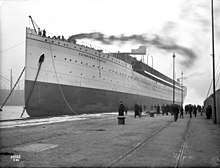Edinburgh Castle (1910 ship)
Edinburgh Castle was an ocean liner operated by the Union-Castle Line in service between Britain and South Africa during the early 20th century.

.jpg) Edinburgh Castle | |
| History | |
|---|---|
| Name: | Edinburgh Castle |
| Owner: |
|
| Operator: |
|
| Builder: | Harland and Wolff, Belfast, Northern Ireland |
| Completed: | 27 January 1910 |
| Maiden voyage: | 21 May 1910 |
| Out of service: | 1938 |
| Fate: | Sunk 1945 |
| General characteristics | |
| Tonnage: | 13,326 GT |
| Length: | 570 ft (170 m) |
| Beam: | 64 ft (20 m) |
| Propulsion: | Compound steam engines |
| Speed: | 16 knots (30 km/h) (service speed) |
| Capacity: | 810 passengers |
She was built by Harland and Wolff of Belfast, launched 27 January 1910.[1] After an opening for public inspection on Whit Monday (16 May 1910) during which about 1,000 persons boarded Edinburgh Castle sailed on 21 May 1910 for South Africa.[2] Edinburgh Castle with sister ship Balmoral Castle[Note 1] were at the time the largest and most powerful vessels in the South African trade.[3]
The ship was operated in line service until 1938, with a break for government service during World War I when she was fitted out as an armed merchant cruiser.[4][5]
Edinburgh Castle was sent from England with supplies and men for the British squadron in the South Atlantic joining the northern elements of Admiral Craddock's forces at their coaling base off the Brazilian coast on 12 October 1914. The ship was retained as part of the fleet to aid in the search for the German cruiser Karlsruhe. On the redistribution of forces after the German victory at the Battle of Coronel Edinburgh Castle was left with two other British ships in the north until 19 November when detached carrying mail for England.[6]
She was laid up in Southampton until she was requisitioned again for wartime service in World War II, during which time she was moored at Freetown to provide shelter for survivors of sunken ships.[4] After the war, she was deemed of little value and sunk as a target west of Freetown.[5]
Edinburgh Castle measured 13,326 gross tons, and was 570 feet (170 m) long with a beam of 64 feet (20 m).[4] She was powered by quadruple expansion steam engines, which drove twin propellers that gave her a service speed of 16 knots (18 mph).[4] She had a passenger capacity of 810—320 in first class, 220 in second class, and 270 in third class.[4]
Notes
- Balmoral Castle was launched 12 November 1909 by The Fairfield Shipbuilding and Engineering Company, Govan.
References
- "Launches-Irish". The Marine Engineer and Naval Architect. XXXII (March): 322. 1910. Retrieved 11 January 2018.
- "The Union Castle Co". The Marine Engineer and Naval Architect. XXXII (June): 434. 1910. Retrieved 11 January 2018.
- "Industrial and Trade Notes — The Clyde and Scotland". The Marine Engineer and Naval Architect. XXXII (December): 184. 1909. Retrieved 11 January 2018.
- Miller Jr., William H. (2001). Picture History of British Ocean Liners 1900 to the Present. Mineola, NY: Dover Publications. pp. 68. ISBN 0-486-41532-5.
- "SS Edinburgh Castle (+1945)". Wrecksite. Retrieved 3 December 2017.
- Spencer-Cooper, H. (1919). The Battle of the Falkland Islands Before and After. London, New York, Toronto and Melbourne: Cassell and Company, LTD. p. 26, 62, 65. Retrieved 12 January 2018.